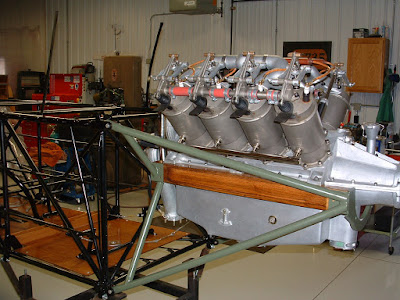First the throttles:
 |
| Original throttle control rod |
I prefer the throttle on the left in tandem seat airplanes, so that is where I decided to put it. This meant changing the controls firewall forward, but the rod back to the levers could remain as original. The photo above shows this rod. The short section attaches to the front throttle lever so the two are slaved together.
 |
| New throttle levers and control rod |
For the firewall forward portion, I had to come up with a torque tube that ran from the left side to the right side with a bell crank and rod attaching to the throttle lever on the right side of the carburetor. Whew, hope you can follow that! The pictures should explain better.
 |
| Control rod attachment to torque tube |
| Torque tube attachment on RH side |
 |
| Attachment to carburetor lever |
When all completed, it came out great with very smooth action and nice travel range of the levers.
Radiator shutters:
The next major item to get sorted (as our British friends would say) was the radiator. I put in an interesting post on the radiator in December 2015. It's worth reading if you haven't already. I still, though, had to fabricate the shutters and control mechanism.
 |
| Levers and bushings for shutter rods |
 |
| Levers welded to shutter rods |
The first thing to make were all the little linkages, levers and bushings to mount the rods for the shutters...
 |
| Completed shutter rods |
 |
| Using tinners rivets to seal up ends of the shutter rods |
I like to seal up the ends of tubing to prevent corrosion. A neat way to do it is with steel tinners rivets. They fit nicely in the end of smaller steel tubing and then are easily welded in.
 |
| Shutters closed |
 |
| Shutters open |
 |
| Shutter linkage |
The end caps, that had to be fabricated as well, contain the linkages that operate the shutters and connect to a control lever in the rear (pilots) cockpit. The bushings previously talked about are brazed into these end caps for the shutter rods to operate smoothly.
Next, I need to come up with covers for the top and bottom of the radiator to protect the core. Then, mounting straps to hold the radiator to the bottom of the engine mount. A control cable to the cockpit lever can then be run.
Things are taking shape - slow but sure!
Also, we are making a big push this year to get our current hangar sold so we can relocate our shop. I realize many readers are too far away, but for those here in our region, it is one of the nicest hangars you'll find. Located at C55 airport in North Central Illinois not far from Rockford. It has a full bathroom with small apartment/office for weekend stays (not zoned as a permanent residence). Please pass the word, or send me an email.
gregh.aviation@gmail.com











